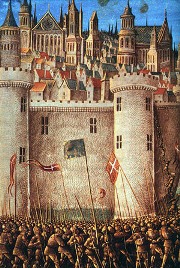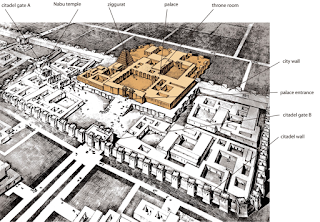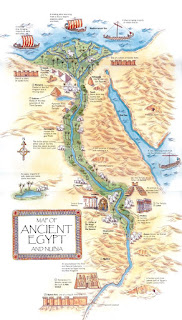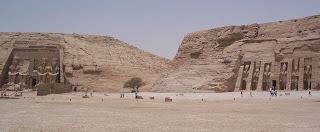MEDIEVAL CITIES UNIT 3
Rise Of Trade And Towns
Although scholars have long debated the extent of trade and urban life
during the early Middle Ages, there is general
agreement that increased trade
activity was evident before the crusades. With the
ending of Viking and Magyar
attacks in the tenth century, a northern trading area
developed, which
extended from the British Isles to the Baltic Sea.
The center of this northern
trade system was the county of Flanders. By
1050 Flemish artisans were producing a surplus of
woolen cloth of such fine
quality that it was in great demand. Baltic furs,
honey and forest products,
and British tin and raw wool were exchanged for
Flemish cloth. From the south
by way of Italy came oriental luxury goods - silks,
sugar, and spices.
Trade Routes And Trade Fairs
A catalyst of the medieval
commercial revolution was the opening of the
Mediterranean trading area. In the eleventh century,
Normans and Italians
broke the Muslim hold on the eastern Mediterranean,
and the First Crusade
revived trade with the Near East. Arab vessels brought
luxury goods from the
East to ports on the Persian Gulf and Red Sea. From
there they were shipped by
caravan to Alexandria, Acre, and Joppa, and from those
ports the merchants of
Venice, Genoa, and Pisa transported the goods to Italy
on their way to the
markets of Europe. Other trade routes from Asia came
overland, passing through
Baghdad and Damascus and on to ports, such as Tyre and
Sidon, in the crusader
states. The easiest route north from the Mediterranean
was by Marseilles and
up the Rhone valley.
Early in the fourteenth
century two more major trade lanes developed
within Europe. An all-sea route connected the
Mediterranean with northern
Europe via the Strait of Gibraltar. The old overland
route from northern Italy
through the Alpine passes to central Europe was also
developed. From Venice
and other northern Italian cities, trade flowed
through such passes as the
Brenner, sharply reducing the business of the Rhone
valley route and the
famous fairs of Champagne.
Along the main European trade
routes, astute lords set up fairs, where
merchants and goods from Italy and northern Europe
met. During the twelfth and
thirteenth centuries the fairs of Champagne in France
functioned as the major
clearing house for this international trade.
Fairs were important and
elaborate events held either seasonally or
annually in specified areas of each European country.
The feudal law of the
region was set aside during a fair, and in its place
was substituted a new
commerical code called the "law merchant."
Special courts, with merchants
acting as judges, settled all disputes. In England
such courts were called
"pie-powder courts," from the French pied
poudre, meaning "dusty foot." Fairs
also greatly stimulated the revival of a money economy
and early forms of
banking and credit.
Factors In The Rise Of Towns
The resurgence of trade in
Europe was a prime cause of the revival of
towns; the towns arose because of trade, but they also
stimulated trade by
providing greater markets and by producing goods for
the merchants to sell.
In this revival, geography
played a significant role. Rivers, important
to the evolution of ancient civilizations, were also
important in the
development of medieval towns. They were natural
highways on which articles of
commerce could be easily transported.
Another factor contributing
to the rise of towns was population growth.
In Britian, for example, the population more than
tripled between 1066 and
1350. The reasons for this rapid increase in
population are varied. The ending
of bloody foreign invasions and, in some areas, the
stabilization of feudal
society were contributing factors. More important was
an increase in food
production brought about by the cultivation of
wastelands, clearing of
forests, and draining of marshes.
Merchant And Craft Guilds
In each town the merchants
and artisans organized themselves into guilds,
which were useful not only for business but also for
social and political
purposes. There were two kinds of guilds: merchant and
craft.
The merchant guild ensured a
monopoly of trade within a given locality.
All alien merchants were supervised closely and made
to pay tolls. Disputes
among merchants were settled at the guild court
according to its own legal
code. The guilds also tried to make sure that the
customers were not cheated:
they checked weights and measures and insisted upon a
standard quality for
goods. To allow only a legitimate profit, the guild
fixed a "just price,"
which was fair to both producer and customer.
The guild's functions
stretched beyond business and politics into
charitable and social activities. A guildsman who fell
into poverty received
aid from the guild. The guild also provided financial
assistance for the
burial expense of its members and looked after their
dependents. Members
attended social meetings in the guildhall and
periodically held processions in
honor of their patron saints.
With the increase of commerce
in the towns, artisans began to organize as
early as the eleventh century. Craftsmen in each of
the medieval trades -
weaving, cobbling, tanning, and so on - joined forces.
The result was the
craft guild, which differed from the merchant guild in
that membership was
limited to artisans in one particular craft.
The general aims of the craft
guilds were the same as those of the
merchant guilds - the creation of a monopoly and the
enforcement of a set of
trade rules. Each guild had a monopoly of a certain
article in a particular
town, and every effort was made to prevent competition
between members of the
same guild. The guild restricted the number of its
members, regulated the
quantity and quality of the goods produced, and set
prices. It also enforced
regulations to protect the consumer from bad workmanship
and inferior
materials.
The craft guild also differed
from the merchant guild in its recognition
of three distinct classes of workers - apprentices,
journeymen, and master
craftsmen. The apprentice was a youth who lived at the
master's house and was
taught the trade thoroughly. Although the apprentice
received no wages, all
his physical needs were supplied. Apprenticeship
commonly lasted seven years.
When the apprentice's schooling was finished, the
youth became a journeyman.
He was then eligible to receive wages and to be hired
by a master. At about
age twenty-three, the journeyman sought admission into
the guild as a master.
To be accepted he had to prove his ability. Some
crafts demanded the making of
a "master piece" - for example, a pair of
shoes that the master shoemakers
would find acceptable in every way.
Acquiring Urban Freedom
The guilds played an
important role in local government. Both artisans
and merchants, even though freemen, were subject to
the feudal lord or bishop
on whose domain the city stood. The citizens of the
towns resented the fact
that their overlord collected tolls and dues as though
they were serfs. The
townsmen demanded the privileges of governing
themselvesof making their own
laws, administering their own justice, levying their
own taxes, and issuing
their own coinage. Naturally the overlord resented the
impertinent upstarts
who demanded self-government. But the towns won their
independence in various
ways.
One way was to become a
commune, a self-governing town. The merchant
guilds took the lead in acquiring charters of
self-government for the towns.
Often a charter had to be won by revolt; in other
circumstances it could be
purchased, for a feudal lord was always in need of
money. By 1200 the Lombard
towns of northern Italy, as well as many French and
Flemish towns, had become
self-governing communes.
Where royal authority was
strong, a town could be favored as
"privileged." In a charter granted to the
town by the monarch, the inhabitants
won extensive financial and legal powers. The town was
given management of its
own finances and paid its taxes in a lump sum to the
king. It was also
generally given the right to elect its own officials.
The king was usually
glad to grant such a charter, for it weakened the
power of the nobles and won
for the monarch the support of the townspeople.
Founding new towns was still
another way in which feudal restrictions
were broken down. Shrewd lords and kings, who
recognized the economic value of
having towns in their territories, founded carefully
planned centers with
well-designed streets and open squares. As a means of
obtaining inhabitants,
they offered many inducements in the form of personal
privileges and tax
limitations.
Interacting with the growth
of towns was the decline of serfdom. Many
serfs escaped from the manors and made their way to
the towns. After living a
year and a day in the town, a serf was considered a
freeman.
The Bourgeoisie
The triumph of the
townspeople in their struggle for greater
self-government meant that a new class evolved in
Europe - a powerful,
independent, and self-assured group, whose interest in
trade was to
revolutionize social, economic, and political history.
The members of this
class were called burghers and came to be called
bourgeoisie. Kings came to
rely more and more on them in combating the power of
the feudal lords, and
their economic interest gave rise to an early
capitalism. Also associated with
the rise of towns and the bourgeoisie were the decline
of serfdom and the
manorial system and the advent of modern society.
A medieval townsman's rank
was based on money and goods rather than birth
and land. At the top of the social scale were the
princes of trade, the great
merchants and banking families, bearing such names as
Medici, Fugger, and
Coeur. Then came the moderately wealthy merchants and
below them the artisans
and small shopkeepers. On the lowest level were the
unskilled laborers, whose
miserable lot and discontent were destined to continue
through the rest of the
Middle Ages.
TASK FOR THURSDAY THE 20TH
INDIVIDUALLY
A. READ THE TEXT
B. HIGHLIGHT THE MOST IMPORTANT IMFORMATION
C. ANSWER THESE QUESTIONS:
1. which were the products each country produced?
2. Where did the most famous fairs take place?
3. Why were fairs important for the economy?
4. Why did trade re-emerge?
5. What facilitated the transportation of goods?
6. Why did towns get bigger?
7. Differences and similarities between the merchant
and the craft guilds.
8. Category of workers : 3
9. Characteristics of these types of workers.
10. Why did citizens envy merchants and artisans?
11. Why was the king in favour of individual towns?
12. Was the emergence of cities beneficial or harmful
for serfs? Why?
13. What is the meaning of burgher?
14. Draw the pyramid of society: artisans and
shopkeepers, unskilled labourers, tradesmen and merchants.































































